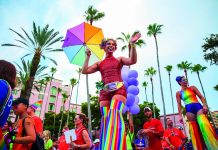
Map illustration by Brainstorm
For decades, Florida’s A1A has been synonymous with beach vacations, a two-lane ticket to fun in the sun. Long stretches hug the Atlantic coast, offering stunning views of the ocean and the sandy shore. And while many of the fruit stands, souvenir shacks, and motor courts that once populated the roadside are long gone, a handful of Old Florida attractions maintain a distinctly vintage vibe—especially along the northern third of the storied roadway. Follow our journey from St. Augustine to New Smyrna Beach, with plenty of stops along the way.
St. Augustine
White stucco walls and red barrel-tile roofs, hallmarks of Spanish Colonial architecture, set the stage for explorations in this oldest of American cities. As one would expect, historic sites abound: centuries-old churches and houses, the oldest wooden school, the Old Jail, and the Castillo de San Marcos, the country’s oldest masonry fort. Take a stroll down St. George Street in the old Spanish Quarter, which is lined with shops, galleries, and eateries, including an outpost of Florida’s (you guessed it) oldest restaurant, the Columbia.
STAY
Villa 1565 | A former Howard Johnson’s, this recently revived motel showcases St. Augustine’s Spanish feel, from its red roof and cobblestone courtyard to its well-preserved coquina exterior. And while the refreshed rooms are neat as a pin, it’s the location—steps from the Fountain of Youth and the Old Town Trolley depot—that makes this motel worthwhile.

Photo courtesy of St. Augustine, Ponte Vedra & the Beaches Visitors and Convention Bureau
SEE
Ponce de Leon’s Fountain of Youth Archaeological Park | With guest books dating back to 1868, this park ranks among Florida’s oldest tourism draws. It marries the legend of Ponce de Leon’s quest for the fabled fount with the very real history of Spanish settlement on what are today the park’s grounds. The charmingly retro Discovery Globe and Navigators’ Planetarium tell the story of Spanish exploration, and replicas of a mission church, watchtower, and Timucuan village bring to life early St. Augustine.
EAT
O’Steen’s Restaurant | In business since 1965, this cash-only diner is renowned for its fried shrimp prepared St. Augustine–style: butterflied to the tail and coated in ultrafine saltine-cracker meal. Order a dozen served with the signature sauce (a house blend of cocktail and tartar), and don’t skimp on other not-to-be-missed menu items: butter grits, homemade banana cream pie, and spicy Minorcan clam chowder, a local tomato-based specialty with datil peppers.

Photo courtesy of St. Augustine Alligator Farm Zoological Park
SEE
St. Augustine Alligator Farm Zoological Park | Another of Florida’s longest-running attractions (opened in 1893), the park houses almost every crocodilian species, 26 in all. See scores of American alligators; lesser-known reptiles such as the Indian gharial and Chinese crocodile; and the zoo’s largest animal, Maximo, a nearly 16-foot, 1,250-pound saltwater croc. The well-maintained park also includes habitats for Komodo dragons, a community of lemurs, and a host of large African birds.
Believe It or Not!
Robert Ripley’s first permanent Odditorium opened in 1950 in St. Augustine. Situated in a circa-1887 Moorish-style castle, it continues to showcase offbeat artifacts, from shrunken heads to the legendary Fiji mermaid.

Photo courtesy of Marineland Dolphin Adventure
DRIVE – 35 miles
The road south rolls past gated golf communities and Publix-anchored strip malls before giving way to maritime hammock, a dense, low-slung forest of wind-gnarled live oaks, cabbage palms, and red bays. Breaks in the canopy offer glimpses of the ocean and the Matanzas River.
Roughly halfway through this leg of the trip, plan to stop at Marineland. Originally designed as a studio of sorts for 1930s filmmakers to shoot underwater footage, the world’s first oceanarium opened to the public in 1938 and evolved into one of the nation’s leading marine research institutions. As the birthplace of dolphin training, Marineland’s stunt-filled shows became a top tourist draw. Today, the focus is on interactive experience, not performance, so plan on a poolside meet-and-greet or even a swim.
Brake once more at Washington Oaks Gardens State Park. The western portion, set along the shores of the Matanzas River and dominated by massive oaks, was once the winter retreat of Owen Young, former chairman of General Electric and RCA, and his wife, Louise. The elaborate ornamental gardens they established on the property—showcasing azaleas, camellias, orchids, and birds of paradise—form the centerpiece of the park. In the eastern section, a series of rare coquina rock formations and tidal pools along the Atlantic shoreline beckon curious beachcombers and photographers.
Flagler Beach
Opened in 1928, the municipal pier with its iconic A-frame entrance is undoubtedly the most recognizable landmark in this laid-back but lively beach community. Visitors will find plenty of live music, alfresco dining, and cool boutiques. The town’s three-story building cap holds developers at bay, and six miles of uncrowded beaches promise plenty of space to swim, sun, or play in its cinnamon-red coquina sand. Beyond the beach, a network of tranquil creeks, estuaries, and lakes make for great kayaking and canoeing.

Photo courtesy of Palm Coast and the Flagler Beaches
STAY
Si Como No Inn | Built in 1947, this brightly colored, nine-room motel—strung with hammocks and planted with a riot of cacti, hibiscus, and potted succulents—seems the love child of a mid-century motor court and a VW hippie bus. (Its name roughly translates to “Sure, why not?”.) Rooms feature hand-painted furniture and beach-kitsch touches, like checkerboards set with seashell pieces. Located just across the street from the ocean and backing up to the Matanzas River, the inn offers unlimited use of all rec equipment, from kayaks to surfboards to beach umbrellas, for $20 a day.
EAT
High Tides at Snack Jack | This oceanside seafood shack featuring open-air dining, bamboo paneling, and yards of twinkling string lights, began serving up seafood, burgers, and beer in 1947. Today, it offers a full bar and an expansive menu, including favorites such as coconut shrimp and mahi Reubens. Tip: Order the Mystery Dessert—a triple-chocolate torte—to go, and heat it up in the microwave at the inn for a gooey, late-night treat.
DRIVE – 43 miles
Bid farewell to Flagler Beach and cruise south along the ocean. As you approach Daytona Beach, high-rise condos and hotels loom. Passing through the city, spot landmark hotels, such as the 1967 Polynesian-themed Aku Tiki Inn (with its 12-foot Easter Island moai totem) and the 1971 Sun Viking Lodge, fronted by a nine-foot Norseman and a Viking longship.

Photo by Whitney Tomasino
Make a short detour in Port Orange and pay a visit to Dunlawton Sugar Mill Gardens. A former sugarcane plantation, the site is now a lushly planted botanical garden featuring the sugar mill ruins. You’ll also spy several concrete dinosaurs, survivors from the property’s stint as Bongoland, a midcentury amusement park complete with a re-created Seminole village, a miniature train, and the resident “monkey host,” a baboon named Bongo.
New Smyrna Beach
This salt-kissed city draws surfers from around the country, who come for some of the most consistent waves on the East Coast. The dude vibe is strongest along Flagler Avenue, home to noteworthy surf shops like Nichols and Quiet Flight, plus loads of restaurants and a shuffleboard center with 20 lighted courts. Historic Canal Street offers Old Florida charm among its shops and cafes set in circa-1920s storefronts.

Photo courtesy of New Smyrna Beach Area Visitors Bureau
EAT
Dairy Queen | Since 1953, the town’s walk-up Dairy Queen has offered soft-serve treats, including, of course, the iconic “cone with the curl on top.” The park-like outdoor seating area offers plenty of blue and yellow picnic tables and ample shade, and when the sun slips beyond the horizon, the vintage neon sign hums to life.

Photo courtesy of New Smyrna Beach Area Visitors Bureau
EAT
JB’s Fish Camp | This rustic compound set on Mosquito Lagoon began life in the late ’70s as a riverside shack. Today, it’s renowned for its clams (grown on-site), steamed blue crab, fried shrimp, and hush puppies (named best in Florida by Fodor’s). Snag a table outside or among the taxidermy and mounted trophy fish in the dining room. After your meal, walk the dock to spot dolphins and manatees, or rent a kayak or paddleboard and explore the peaceful waters.
Best birding
During summer months, spot ruby-throated hummingbirds from the dune walkover at Jungle Hut Park just north of Flagler Beach.
This article appears in the Spring & Summer 2022 issue of Southbound.















